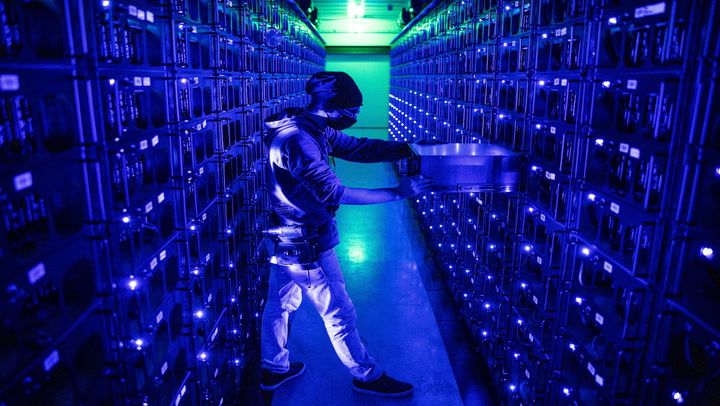Uncategorized
Manufacturers Are Building ASICs That Look More Like Servers. Here’s Why: Blockspace

In the beginning, there were only CPUs, then GPUs, for bitcoin mining. Then came the mighty ASIC in 2013, and with it, the “shoebox” form factor that has become emblematic of the bitcoin mining industry.
What comes next? Will the shoebox design persist as standard for bitcoin mining ASICs? Or will another form factor that more resembles traditional datacenter servers win out?
ASIC manufacturers are increasingly betting on the latter – or at least, that a hydro-cooled server rack design will become a substantial portion of bitcoin mining fleets. Moreover, they’re leaning into the “direct-to-chip” cooling for further efficiency gains.

Last September, Bitmain announced its model U3S21EXPH (a bit of a mouthful, eh?) developed in a partnership with Hut 8. Its U3 design means that one unit takes up three spaces in a traditional server rack. MicroBT soon followed with its M63 Hydro series, as did Bitdeer’s Sealminer A2 Hydro unit.
Following suit, Auradine released its server rack model, the AH3880, this March. Its U2 design, which occupies two server slots, is a bit smaller, but it packs more hashrate per unit of space at 600 TH/s (or 300 TH/s per slot) versus Bitmain’s 860 TH/s (286.66 TH/s per slot).
Shoebox out
So, what’s with the switch up from the traditional shoe box? For Auradine, it’s all about customer demand.
“[Our new model is] based upon a lot of feedback that we got from our miner customers … we’ve been working with the miners even throughout the design process,” Auradine CSO Sanjay Gupta said on the most recent Mining Pod. “They indicated to us that they were looking for a quality hydro based miner.”
In its partnership with Bitmain for the U3S21EXPH, “Hut 8 was instrumental in the custom design for the infrastructure, particularly the U form factor which is compatible with HPC style architecture,” Hut 8 Head of Investor Relations Sue Ennis told Blockspace last September. (More on the high performance computing angle later).
The benefit of a server rack ASIC lies in standardization. Bitcoin miners are increasingly marching in step with the traditional datacenter industry, and that industry could see 40% adoption of direct liquid-to-chip cooling by 2026, according to data center developer Cyrus One.
If miners adopt this design, then theoretically, they can optimize their supply chains by converging on server designs that are becoming best practice in the big-boy data center sector.
This could make building and repairing bitcoin mines easier. And it could also make mining companies more nimble if they want to flex out of bitcoin mining and into other forms of compute.
Enter AI and HPC
As with so much mining news today, of course the spectre of AI is looming in the background.
If miners construct their data centers with traditional server rack designs, there is one less pain point if they want to retrofit these sites for AI and HPC loads. Of course, they’d still need to augment the sinews, muscles and veins of their operations with more robust networking and electrical infrastructure, but server racks would provide a backbone for AI/HPC services that requires less restructuring than legacy bitcoin mines. As Ennis put it, “the U form factor … is compatible with HPC style architecture.”
Echoing this, Gupta said in our Mining Pod interview that “[The U form factor has] been used for the AI data center. It’s easy to adjust. It’s got a high [power] density to it … [it] is extremely relevant for AI data centers as well, and we are looking at a joint strategy between AI for HPC and Bitcoin mining. So the U form factor works well with that.”
Who’s buying it?
Perhaps needless to say, the server rack form factor for bitcoin mining is still in its infancy, and while there is promise that such a design could win out, there’s no guarantee.
To start, bitcoin miners will not only need to rework the innards of their mines but also completely rewire their electrical infrastructure (which is unlikely to happen at existing mines).
Cholla’s Brad Cuddy, which operates hydro-cooled ASIC miners, told Blockspace last September that “he’s excited to see the shift from the shoebox design to the [server rack] form factor.” But he said the U3S21EXPH’s voltage range is incompatible with certain electrical infrastructure that miners use with other Bitmain models.
“The restricted range of 380 to 415 volts reduces its compatibility for retrofitting. I would have liked to see the voltage range go all the way up to 480 volts to allow for more interoperability with current infrastructure deployments,” he said.
As such, it’s likely that we’ll see miners integrate these units at new sites. Hut 8 is taking this approach with plans to host 15 EH/s of U3S21EXPH units for Bitmain (with an option to purchase) at its Vega, Texas site, which is due to start operating in Q2.
So far, Hut 8 is the only public buyer of Bitmain’s U3S21EXPH. Gupta did not reveal which miners are under contract for its AH3880, but he did say they include several industrial scale private and public miners. It wouldn’t be surprising to see MARA, one of Auradine’s key partners which has also invested upwards of $50 million in the company, adopt the model.
Should Hut 8’s Vega site run smoothly on Bitmain’s model, and if we assume that MARA will deploy Auradine’s, public miners may lead where others will follow, and we could see a new form factor slowly seep into modern mine design.
Business
Crypto Trading Firm Keyrock Buys Luxembourg’s Turing Capital in Asset Management Push

Crypto trading firm Keyrock said it’s expanding into asset and wealth management by acquiring Turing Capital, a Luxembourg-registered alternative investment fund manager.
The deal, announced on Tuesday, marks the launch of Keyrock’s Asset and Wealth Management division, a new business unit dedicated to institutional clients and private investors.
Keyrock, founded in Brussels, Belgium and best known for its work in market making, options and OTC trading, said it will fold Turing Capital’s investment strategies and Luxembourg fund management structure into its wider platform. The division will be led by Turing Capital co-founder Jorge Schnura, who joins Keyrock’s executive committee as president of the unit.
The company said the expansion will allow it to provide services across the full lifecycle of digital assets, from liquidity provision to long-term investment strategies. «In the near future, all assets will live onchain,» Schnura said, noting that the merger positions the group to capture opportunities as traditional financial products migrate to blockchain rails.
Keyrock has also applied for regulatory approval under the EU’s crypto framework MiCA through a filing with Liechtenstein’s financial regulator. If approved, the firm plans to offer portfolio management and advisory services, aiming to compete directly with traditional asset managers as well as crypto-native players.
«Today’s launch sets the stage for our longer-term ambition: bringing asset management on-chain in a way that truly meets institutional standards,» Keyrock CSO Juan David Mendieta said in a statement.
Read more: Stablecoin Payments Projected to Top $1T Annually by 2030, Market Maker Keyrock Says
Business
Crypto Trading Firm Keyrock Buys Luxembourg’s Turing Capital in Asset Management Push

Crypto trading firm Keyrock said it’s expanding into asset and wealth management by acquiring Turing Capital, a Luxembourg-registered alternative investment fund manager.
The deal, announced on Tuesday, marks the launch of Keyrock’s Asset and Wealth Management division, a new business unit dedicated to institutional clients and private investors.
Keyrock, founded in Brussels, Belgium and best known for its work in market making, options and OTC trading, said it will fold Turing Capital’s investment strategies and Luxembourg fund management structure into its wider platform. The division will be led by Turing Capital co-founder Jorge Schnura, who joins Keyrock’s executive committee as president of the unit.
The company said the expansion will allow it to provide services across the full lifecycle of digital assets, from liquidity provision to long-term investment strategies. «In the near future, all assets will live onchain,» Schnura said, noting that the merger positions the group to capture opportunities as traditional financial products migrate to blockchain rails.
Keyrock has also applied for regulatory approval under the EU’s crypto framework MiCA through a filing with Liechtenstein’s financial regulator. If approved, the firm plans to offer portfolio management and advisory services, aiming to compete directly with traditional asset managers as well as crypto-native players.
«Today’s launch sets the stage for our longer-term ambition: bringing asset management on-chain in a way that truly meets institutional standards,» Keyrock CSO Juan David Mendieta said in a statement.
Read more: Stablecoin Payments Projected to Top $1T Annually by 2030, Market Maker Keyrock Says
Business
Gemini Shares Slide 6%, Extending Post-IPO Slump to 24%

Gemini Space Station (GEMI), the crypto exchange founded by Cameron and Tyler Winklevoss, has seen its shares tumble by more than 20% since listing on the Nasdaq last Friday.
The stock is down around 6% on Tuesday, trading at $30.42, and has dropped nearly 24% over the past week. The sharp decline follows an initial surge after the company raised $425 million in its IPO, pricing shares at $28 and valuing the firm at $3.3 billion before trading began.
On its first day, GEMI spiked to $45.89 before closing at $32 — a 14% premium to its offer price. But since hitting that high, shares have plunged more than 34%, erasing most of the early enthusiasm from public market investors.
The broader crypto equity market has remained more stable. Coinbase (COIN), the largest U.S. crypto exchange, is flat over the past week. Robinhood (HOOD), which derives part of its revenue from crypto, is down 3%. Token issuer Circle (CRCL), on the other hand, is up 13% over the same period.
Part of the pressure on Gemini’s stock may stem from its financials. The company posted a $283 million net loss in the first half of 2025, following a $159 million loss in all of 2024. Despite raising fresh capital, the numbers suggest the business is still far from turning a profit.
Compass Point analyst Ed Engel noted that GEMI is currently trading at 26 times its annualized first-half revenue. That multiple — often used to gauge whether a stock is expensive — means investors are paying 26 dollars for every dollar the company is expected to generate in sales this year. For a loss-making company in a volatile sector, that’s a steep price, and could be fueling investor skepticism.
-

 Business11 месяцев ago
Business11 месяцев ago3 Ways to make your business presentation more relatable
-

 Fashion11 месяцев ago
Fashion11 месяцев agoAccording to Dior Couture, this taboo fashion accessory is back
-

 Entertainment11 месяцев ago
Entertainment11 месяцев ago10 Artists who retired from music and made a comeback
-

 Entertainment11 месяцев ago
Entertainment11 месяцев ago\’Better Call Saul\’ has been renewed for a fourth season
-

 Entertainment11 месяцев ago
Entertainment11 месяцев agoNew Season 8 Walking Dead trailer flashes forward in time
-

 Business11 месяцев ago
Business11 месяцев ago15 Habits that could be hurting your business relationships
-

 Entertainment11 месяцев ago
Entertainment11 месяцев agoMeet Superman\’s grandfather in new trailer for Krypton
-

 Entertainment11 месяцев ago
Entertainment11 месяцев agoDisney\’s live-action Aladdin finally finds its stars




